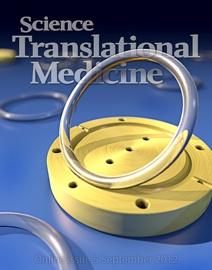Sci Transl Med:促進藥物通過血腦屏障的納米技術取得新突破
大腦是一種很難治療的器官,在近期刊登在《Science Translational Medicine》期刊上的一項研究,來自美國約翰霍普金斯大學的研究人員說,他們已設計出一種改進的納米顆粒,當在鼠類和人組織上接受測試時,它能夠安全和可預見性地深入滲透進大腦之中。并且他們發現一種方法來阻止嵌入藥物的納米顆粒附著到它們的周圍環境之中,這樣當進入大腦時,它們能夠擴散開來。
在利用手術移除腦瘤之后,包括將化療藥物直接施加到手術位點之中的標準治療方法被用來殺死利用手術不能除去的任何癌細胞。迄今為止,這種阻止腫瘤復發的方法只取得部分成功,這是因為很難施加足夠高劑量的化療藥物來充分地穿過大腦組織,在確保療效的同時也要保證劑量足夠低以便讓病人和健康組織不遭受毒副作用。
為了克服這種劑量挑戰,研究人員設計出在一段時間內穩定地運送少量藥物的納米顆粒。常規性運送藥物的納米顆粒是在嚴緊的球中,通過將藥物分子與微觀的繩狀分子捕獲在一起而產生的,而當與水接觸時,它們緩慢地降解。但是這些納米顆粒并不能非常好地發揮作用,這是因為在注射位點,它們與細胞粘附在一起,因而不能更加深入地遷移到組織之中。
論文第一作者Elizabeth Nance和神經外科醫師Graeme Woodworth博士猜測,如果運送藥物的納米顆粒與它們的周邊環境發生的相互作用最小化,那么藥物滲透作用可能會得到改善。Nance首先利用一種臨床測試分子聚乙二醇(PEG)來包被不同大小的納米塑料珠,其中其他人已證實PEG能夠保護納米顆粒不受體內防御機制的破壞。研究人員也推斷一層厚的PEG可能也讓這些珠子更加光滑。
研究人員將這些包被有PEG的塑料珠注射到鼠類和人大腦組織切片之中。他們首先利用發光的標簽來標記這些塑料珠,從而能夠讓他們觀察這些塑料珠在組織中的移動。與沒有包被PEG的珠子或寶貝一層薄的EPEG的珠子相比,一層厚的PEG允許更大的珠子滲透大腦組織,甚至這些珠子將近是人們之前認為可能在大腦內滲透的最大大小的2倍時,它們也能滲透。他們然后在活的鼠類大腦中測試了這些珠子,并發現了同樣的研究結果。
研究人員隨后研究了攜帶化療藥物紫杉醇(paclitaxel)的生物可降解的納米顆粒,并利用PEG包被它們。 與期待中的一樣,在大鼠腦組織中,沒有PEG包被的納米顆粒極少移動,而包被有PEG的納米顆粒在腦組織中非常好地分布。
Nance說,“非常令人興奮的是,我們如今擁有能夠攜帶5倍多藥物的納米顆粒,能夠在3倍長的時間內釋放這種藥物,而且在腦組織中更深地滲透。下一步就是觀察我們是否能夠延緩鼠類動物體內腫瘤生長或復發。”

A Dense Poly(Ethylene Glycol) Coating Improves Penetration of Large Polymeric Nanoparticles Within Brain Tissue
Elizabeth A. Nance1,2,*, Graeme F. Woodworth1,3,*, Kurt A. Sailor4, Ting-Yu Shih2, Qingguo Xu1,5, Ganesh Swaminathan2, Dennis Xiang2, Charles Eberhart1,5,6 and Justin Hanes
Prevailing opinion suggests that only substances up to 64 nm in diameter can move at appreciable rates through the brain extracellular space (ECS). This size range is large enough to allow diffusion of signaling molecules, nutrients, and metabolic waste products, but too small to allow efficient penetration of most particulate drug delivery systems and viruses carrying therapeutic genes, thereby limiting effectiveness of many potential therapies. We analyzed the movements of nanoparticles of various diameters and surface coatings within fresh human and rat brain tissue ex vivo and mouse brain in vivo. Nanoparticles as large as 114 nm in diameter diffused within the human and rat brain, but only if they were densely coated with poly(ethylene glycol) (PEG). Using these minimally adhesive PEG-coated particles, we estimated that human brain tissue ECS has some pores larger than 200 nm and that more than one-quarter of all pores are ≥100 nm. These findings were confirmed in vivo in mice, where 40- and 100-nm, but not 200-nm, nanoparticles spread rapidly within brain tissue, only if densely coated with PEG. Similar results were observed in rat brain tissue with paclitaxel-loaded biodegradable nanoparticles of similar size (85 nm) and surface properties. The ability to achieve brain penetration with larger nanoparticles is expected to allow more uniform, longer-lasting, and effective delivery of drugs within the brain, and may find use in the treatment of brain tumors, stroke, neuroinflammation, and other brain diseases where the blood-brain barrier is compromised or where local delivery strategies are feasible.
本站所注明來源為"愛愛醫"的文章,版權歸作者與本站共同所有,非經授權不得轉載。
本站所有轉載文章系出于傳遞更多信息之目的,且明確注明來源和作者,不希望被轉載的媒體或個人可與我們
聯系zlzs@120.net,我們將立即進行刪除處理
熱點圖文
-
多參數MRI在前列腺癌精準診斷應用思考
隨著前列腺癌發病率的逐年上升,精準診斷與分層治療成為改善患者預后的關鍵。多...[詳細]
-
帶狀皰疹神經疼痛的臨床診療
綜合治療的必要性帶狀皰疹神經痛的治療需要多模式、多學科的綜合治療策略。結合...[詳細]

